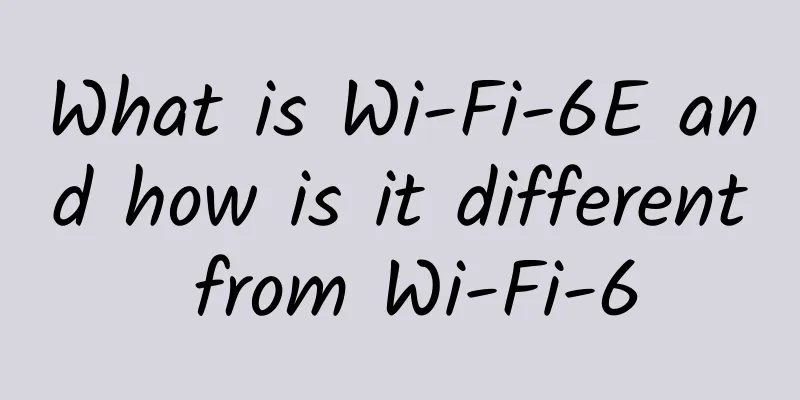What is Wi-Fi-6E and how is it different from Wi-Fi-6

|
Three years ago, Wi-Fi 6 technology entered the market, bringing faster speeds, lower latency, and improved security to many homes. Since then, a series of technological developments have made the Wi-Fi experience even better. As cable Internet service providers continue to stay ahead of consumer needs and be at the forefront of innovation, here's what these developments mean for consumers. What is Wi-Fi-6E and how is it different from Wi-Fi-6Wi-Fi 6 is the name of the latest generation of Wi-Fi technology released in 2019. The sixth generation of Wi-Fi technology helps ease network congestion and delivers gigabit speeds, paving the way for the 10G speeds promised by the cable industry to be available in homes across the country. Wi-Fi 6E refers to the latest generation of Wi-Fi 6 technology, which takes advantage of a new band of wireless spectrum. The FCC approved the unlicensed use of the 6 GHz band in 2020, providing much-needed bandwidth for routers. 6 GHz marks the largest increase in Wi-Fi spectrum since 1989. As more devices come online and utilize the wireless spectrum, the airwaves are becoming more crowded. PCMag reports that the 6 GHz band has four times the number of available channels for Wi-Fi, which means Wi-Fi 6E routers and devices are more flexible than Wi-Fi 6 technology. These new technologies include Wi-Fi connected devices, from routers to smart light bulbs to tablets. Wi-Fi 6/E is also backward compatible, which means that if someone buys a new smart speaker running the new standard, it will still work fine on Wi-Fi 5. This way, as devices are upgraded and replaced, connections will become faster and the transition will be smooth. In short, the difference in Wi-Fi-6/E technology is efficiency. Many of the updates are innovative solutions that make Wi-Fi functions better and smarter. Here is a brief analysis of two of these developments and what they enable for end users. modulationWi-Fi-6/E brings a more efficient way to package data as it travels on a single signal, resulting in four times the data rate for a given channel, thus increasing network speeds. Battery LifeEach version of the Wi-Fi standard improves the battery life of devices using the network. As each version brings faster speeds, data is transferred faster and devices do not consume as much energy. And, Wi-Fi 6/E will further improve battery savings through a feature called target wake time. It has a feature called target wake time. This feature puts the device into a low-power mode. These short sleep periods will increase battery life. These are just two highlights of the Wi-Fi 6 and Wi-Fi 6E updates. These and many other improvements will ensure that users will not be slowed down by crowded Wi-Fi networks and will get the full experience of gigabit speeds. As the Internet of Things continues to grow, better network management will make a huge difference. |
<<: Industry 4.0 is driving enterprise fiber access
>>: Learn more about 5G infrastructure
Recommend
Extend PoE Distance: Unlock the Maximum Range of Power over Ethernet
Power over Ethernet (PoE) has revolutionized the ...
CloudCone: $1.99/month KVM-768MB/15GB/3TB/Los Angeles MC Data Center
CloudCone's 2021 flash sale has started again...
BICS Group acquires 3m Digital Networks to accelerate transformation into communications platform provider
MicrosoftInternetExplorer402DocumentNotSpecified7....
TNAHosting: 12G memory 500GB hard disk OpenVZ monthly payment from $5, 4G memory KVM monthly payment of $5
Some businesses give people the impression that t...
Let’s talk about HTTP pipelining
HTTP pipelining is a technique for sending multip...
8 ways to make Android a powerful productivity tool
【51CTO.com Quick Translation】 According to a surv...
Just now! ZTE Announcement: Affected by the rejection order, the company's main business activities can no longer be carried out!
On the evening of May 9, ZTE issued an announceme...
Smart City - Application Areas of 5G
Smart city is one of the three major application ...
5 web trends you need to know about in 2021
On December 14, 2020, a massive network outage ca...
5G has entered its ramp-up phase, and this key factor determines its success or failure...
[[414891]] This article is reprinted from the WeC...
Whether to adopt blockchain is always a matter of choice
Blockchain is currently a technology that has att...
[Understand Routing in Seconds] Now that we have an IP address, is a MAC address still necessary?
I wonder if you are confused: Why do we need a MA...
A thread pool that novices can understand at a glance
I believe everyone can feel that using multithrea...
The shortest path to microservice containerization, best practices for microservices on C
Preface Microservices, as a more flexible, reliab...
Which is better, Wi-Fi6, Wi-Fi6E or Wi-Fi7?
With the popularity of Wi-Fi 6 and Wi-Fi 6E, a ne...









